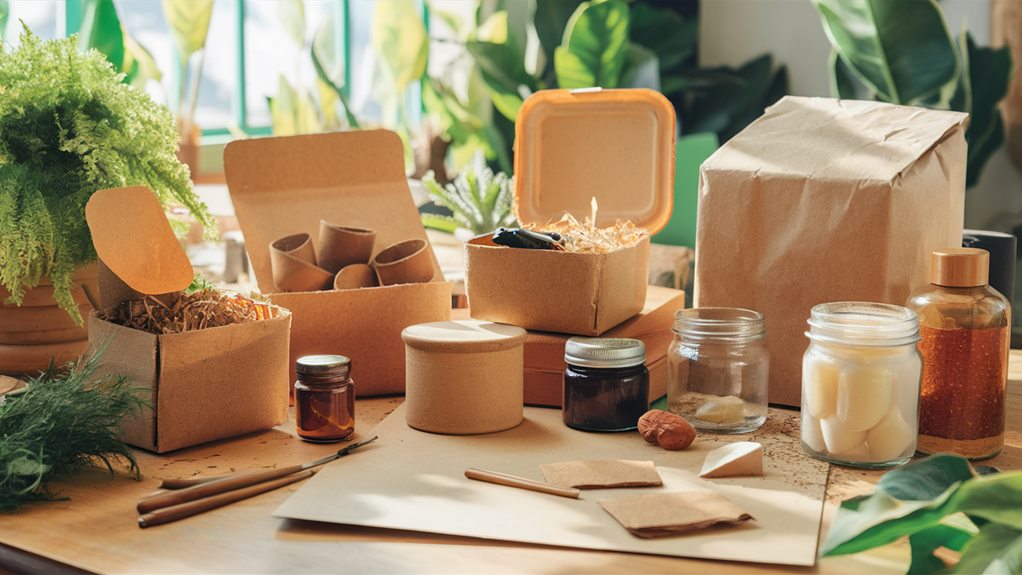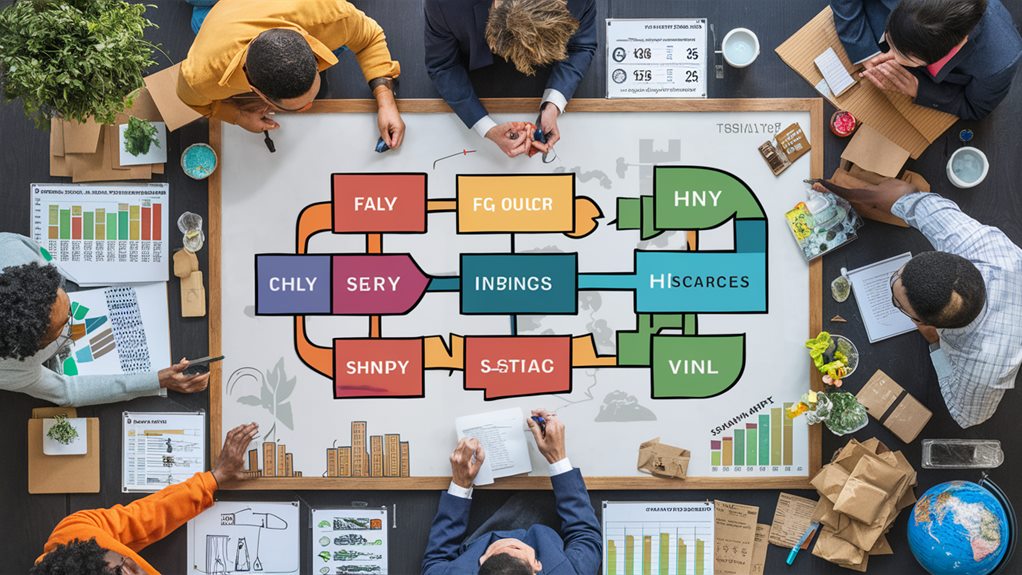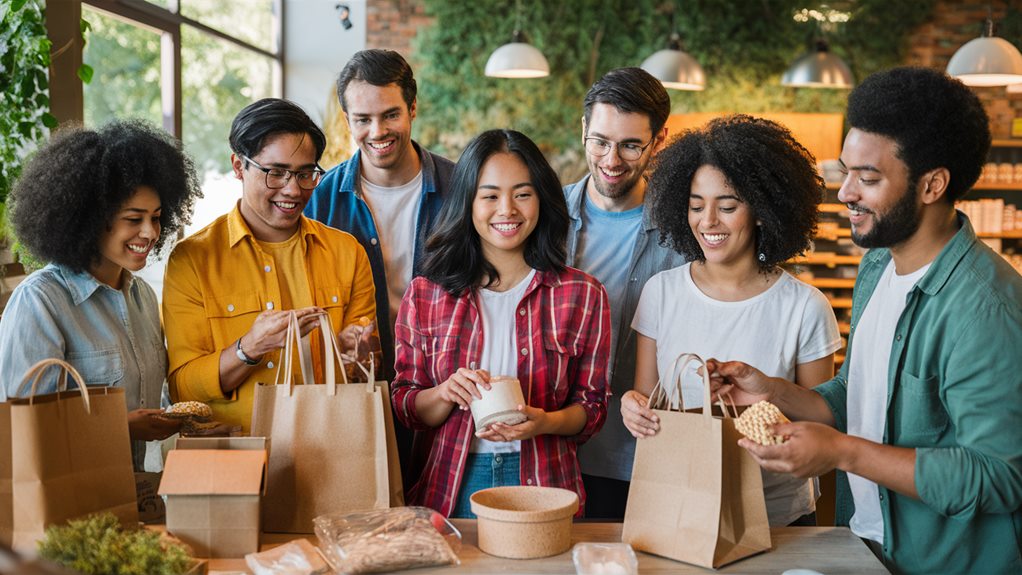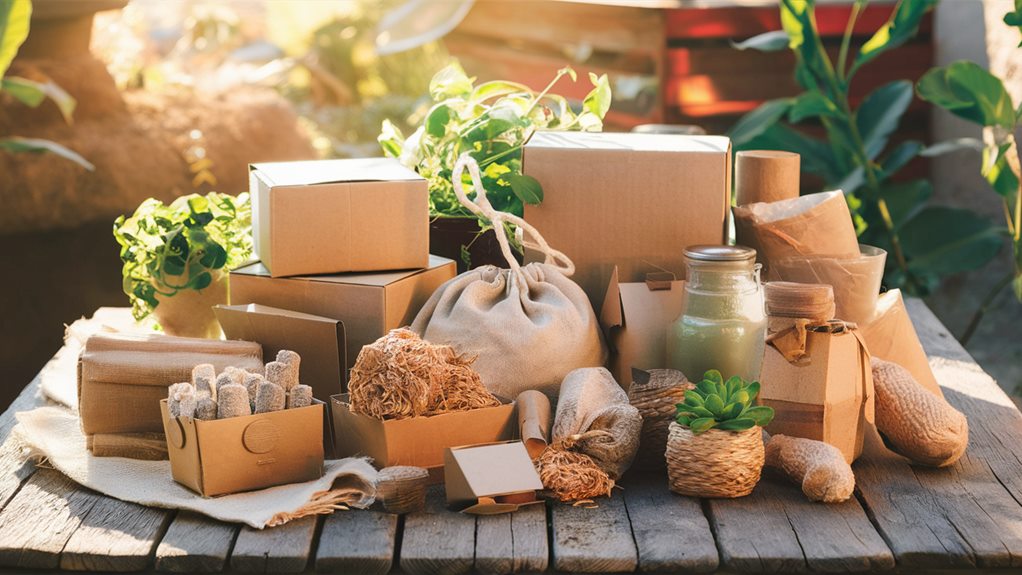To successfully shift to sustainable packaging, start by choosing the right materials. Opt for biodegradable, recyclable, or renewable resources like kraft paper or plant-based plastics. Next, assess your supply chain. Collaborate with suppliers committed to sustainable practices to reduce waste and lower emissions. Ultimately, engage with your customers; offer eco-friendly products and actively seek their feedback. This not only strengthens relationships but also aligns your brand with their values. By taking these steps, you'll enhance your brand's commitment to sustainability and connect with eco-conscious consumers, paving the way for further insights into effective practices.
Key Takeaways
- Prioritize biodegradable, recyclable, or renewable materials like kraft paper or plant-based plastics to enhance sustainability in packaging.
- Evaluate your supply chain to partner with suppliers committed to reducing waste and adopting sustainable practices.
- Engage with customers by offering eco-friendly options and soliciting feedback to align packaging with their sustainability values.
- Streamline packaging processes to minimize excess materials and lower overall carbon emissions in your operations.
- Use social media to share your sustainable journey and foster a community around eco-conscious practices, encouraging customer discussions.
Choose the Right Materials

When selecting materials for sustainable packaging, consider the environmental impact of your choices. You want to prioritize materials that are biodegradable, recyclable, or made from renewable resources. Look for options like kraft paper, plant-based plastics, or recycled materials. Each of these choices reduces waste significantly and can help you connect with eco-conscious consumers who value sustainability. For instance, using biodegradable trash bags can enhance your brand's commitment to eco-friendly practices.
Cost efficiency is also vital in your decision-making process. While some sustainable materials may have a higher upfront cost, they can lead to savings in waste management and disposal in the long run. Additionally, many consumers are willing to pay a premium for products that align with their environmental values, which could boost your sales.
As you evaluate different materials, assess their life cycle—from production to disposal. Make sure you're choosing options that not only minimize environmental harm but also fit within your budget. This balance between cost and sustainability is crucial for building a responsible brand.
When you make informed choices, you're not just contributing to the planet's health; you're also fostering a sense of belonging in a community that values sustainability. By choosing wisely, you set a positive example for others in your industry.
Assess Your Supply Chain

Evaluating your supply chain is a critical step in the shift to sustainable packaging. To make meaningful changes, you need to assess every link in your supply chain, starting with your suppliers. Are they committed to sustainable practices? By evaluating suppliers, you can identify those who share your values and are willing to help you reduce waste in your packaging process. This not only strengthens your environmental goals but also fosters a sense of community within your industry.
For instance, partnering with brands that prioritize eco-friendly dish soaps can inspire innovative approaches to sustainability.
Next, look closely at your materials and logistics. Consider how products are sourced and transported. Can you streamline these processes to minimize excess packaging and lower carbon emissions? Collaborating with suppliers who prioritize eco-friendly practices can lead to innovative solutions that benefit both parties.
Additionally, take a hard look at your waste management strategies. Are there opportunities to recycle or repurpose materials? By addressing these aspects, you can effectively reduce waste and enhance your brand's commitment to sustainability. Engaging with your supply chain in this way creates a shared responsibility, fostering a sense of belonging among all stakeholders in your journey toward sustainable packaging.
Engage With Your Customers

After evaluating your supply chain, it's pivotal to turn your focus to your customers. Engaging with them isn't just about selling; it's about building a community around your sustainable packaging efforts. Consider offering eco-friendly product options, such as home fragrance gift ideas, that align with your sustainability goals.
Start by soliciting customer feedback. This can guide your decisions and show that you value their opinions. Create surveys or feedback forms to gather insights on how your packaging impacts their experience.
Next, leverage social media engagement. Use your platforms to share your sustainable journey, showcasing the materials and processes you've adopted. Posting behind-the-scenes content can foster a sense of belonging among your audience, making them feel part of your mission.
Encourage discussions by asking questions related to sustainability, and respond promptly to comments. This two-way communication not only strengthens customer relationships but also generates a wealth of ideas for your future initiatives.
Frequently Asked Questions
What Are the Cost Implications of Switching to Sustainable Packaging?
Switching to sustainable packaging can have significant cost implications. Initially, you might face higher material costs, but careful material selection can lead to long-term cost savings. By choosing eco-friendly options, you could reduce waste disposal fees and possibly lower shipping costs due to lighter materials. Plus, consumers often prefer brands that prioritize sustainability, potentially boosting your sales and profitability. Balancing these factors can help you make an informed decision for your business.
How Can I Measure the Environmental Impact of My Packaging?
Measuring your packaging's environmental impact might feel like trying to weigh a cloud. Start with a life cycle analysis to assess every stage, from production to disposal. This will reveal the carbon footprint of your materials, helping you understand their true cost to the planet.
Are There Certifications for Sustainable Packaging Options?
Yes, there are several certification standards for sustainable packaging options. You can look for certifications like FSC (Forest Stewardship Council) or Cradle to Cradle, which guarantee eco-friendly materials are used. These certifications not only verify sustainability claims but also enhance your brand's credibility.
What Are Common Misconceptions About Sustainable Packaging?
Did you know that 70% of consumers believe all packaging labeled as "green" is sustainable? This misconception often leads to greenwashing dangers, where companies exaggerate their eco-friendly claims.
You might misunderstand the benefits of sustainable packaging, thinking it's always costly or ineffective. Consumer perceptions vary widely, and industry challenges can complicate the shift.
It's crucial to critically evaluate claims and seek genuine sustainability to truly make a positive impact.
How Can I Train My Staff on Sustainable Packaging Practices?
To train your staff on sustainable packaging practices, start by incorporating sustainability metrics into your training sessions. Use real-world examples to highlight the impact of their choices.
Create engaging workshops that encourage teamwork and discussions. Encourage questions and collaboration to foster a sense of belonging.
Regularly review progress and celebrate successes to keep motivation high. Remember, the more involved your team feels, the more likely they'll embrace sustainable practices wholeheartedly.
Conclusion
As you begin on your journey toward sustainable packaging, envision the ripple effect of your choices—lush forests thriving, oceans teeming with life, and a community that values eco-consciousness. By selecting the right materials, evaluating your supply chain, and engaging your customers, you'll not only reduce your environmental footprint but also inspire others to follow suit. Embrace this opportunity to create a brighter future, where your packaging reflects your commitment to the planet and resonates with your audience.

